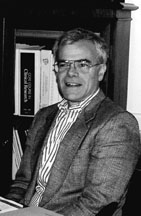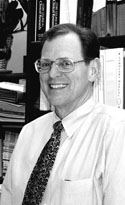

| T H E N I H C A T A L Y S T | J A N U A R Y - F E B R U A R Y 1 9 9 8 |
| F R O M T H E D E P U T Y D I R E C T O R F O R I N T R A M U R A L R E S E A R C H | |
SUPPORT FOR CLINICAL RESEARCH BY NIH: AN UPDATE
 
|
Our commitment to improve the environment for clinical research at NIH is beginning to catalyze change across campus. This column is a progress report on accomplishments in this realm--realized and projected.
NIH Director's Clinical Research Panel
In the spring of 1995, NIH Director Harold Varmus empaneled a group of extramural clinical researchers and academic and industry leaders to recommend measures to stimulate and support clinical research in the United States. The panel's report, presented to the Advisory Committee of the NIH director, includes some major new initiatives NIH is undertaking, such as enhanced clinical research training awards for young investigators and support mechanisms for midcareer investigators, a loan repayment program for clinical researchers, and an NIH-based clinical research training program for medical students (see below).
Clinical Research Training Program
Responding to the director's panel, NIH now has a Clinical Research Training Program for medical students who have completed their principal clinical rotations (usually third year). This year, we welcomed the first class of CRTP fellows--nine students, some living in a group house on campus (formerly the director's residence) and all working on clinical research projects (under the supervision of some of our most outstanding clinical researchers (see
NIH Committee on the Recruitment and Career Development of Clinical Investigators
In early 1996, the Scientific Directors concluded that recruiting new and outstanding clinical researchers to NIH was both a great challenge and crucial to efforts to enhance clinical research activities. Steve Straus, chief of the Laboratory of Clinical Investigation, NIAID, chaired the interinstitute committee that came up with ways to attract and maintain our talent pool (see "Clinical Research Action Plan," September-October 1997, page 1). Among those being implemented are increased salary scales for tenure-track and tenured clinical researchers, a longer tenure track for clinical investigators, establishment of a clinical research advisory committee (chaired by NCI's Tom Waldmann) to the Central Tenure Committee, enhanced status of NIH clinical directors, and creation of a Clinical Research Revitalization Committee to pursue the more general concerns of the original Straus Committee (see below).
Clinical Research Revitalization Committee
Steve Straus chairs this new standing committee. It is exploring innovative ways to improve clinical research support services and patient care in the Clinical Center (CC) and setting standards (with the Medical Executive Committee) for staff clinician promotion. Recommendations will be acted upon as they arise.
Clinical Research Center Activities
John Gallin, associate director for clinical research and CC director, has taken the lead in a series of recruitment, training, and management activities that have fostered clinical research at the NIH CC. The recruitment of Nick Bryan as CC radiology chief and associate director of radiological imaging is one key appointment. A CC Board of Governors, constituted by the HHS secretary and working with Gallin, has been examining CC management and budget for the past year and has helped keep CC costs stable. A CC Advisory Committee (CCAC), chaired by Steve Hyman, NIMH director, and Ed Liu, scientific director of NCI's Division of Clinical Sciences, now exists to consider such programmatic and scientific issues as the organization of the patient care units in the new Clinical Research Center (CRC) and the dispersal to the Institutes of carryover funds from CC savings. The CCAC, with the scientific directors and institute directors, will also shape the process to allocate CRC laboratory space. Ultimate decisions on lab assignments will be made by the NIH director, with the advice of a committee representing clinical investigators, clinical directors, scientific directors, and institute directors.
The Mark O. Hatfield Clinical Research Center
Groundbreaking for our new CRC occurred on November 4, 1997. Special guests, including Senator Hatfield, Vice President Gore, and two NIH patients, spoke glowingly of NIH contributions to basic science and clinical research (see "Clinical Research Center Moves from the Drawing Boards . . ," November-December 1997, pages 6-7). Site preparation began with demolition of the apartment building (Building 30), amidst the well-publicized, if only partially effective, effort to save venerable trees on the site. We expect excavation to start in October 1998 and the building to be complete by the end of 2001. This state-of-the-art facility will offer a dramatically improved physical environment for conducting clinical and translational research.
Other Clinical Research Activities
Building on last year's impressive and morale-boosting Clinical Research Day, at which many of our top researchers showcased their work, this year's NIH Research Festival will highlight clinical research activities. Scott Whitcup, NEI clinical director and incoming chair of the Medical Executive Committee, will help organize the festival with Art Levine, NICHD scientific director, and Story Landis, NINDS scientific director. A recent generous gift pledged by NCI scientist emeritus Robert W. Miller and his wife Haruko Miller, a retired NCI research technician, will establish an NIH Director's Lecture to honor astute clinical observations that led to important laboratory research. And, finally, NIH Clinical Center protocols can now be accessed by all via a fully searchable Web site at <http://www.cc.nih.gov/nihstudies/>, a development that will greatly simplify the patient referral process (see "Just Ask," page 3).
As always, we welcome your suggestions for further improvement.